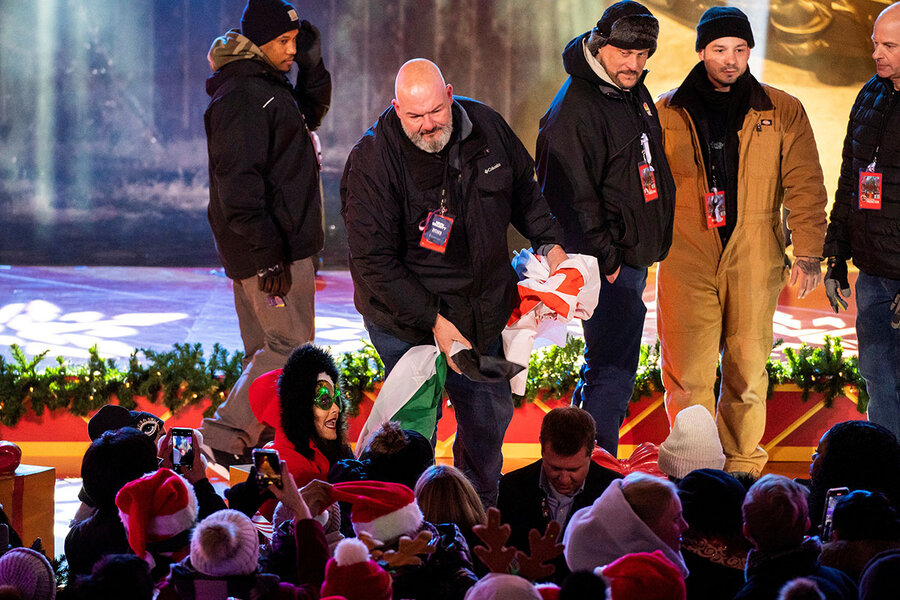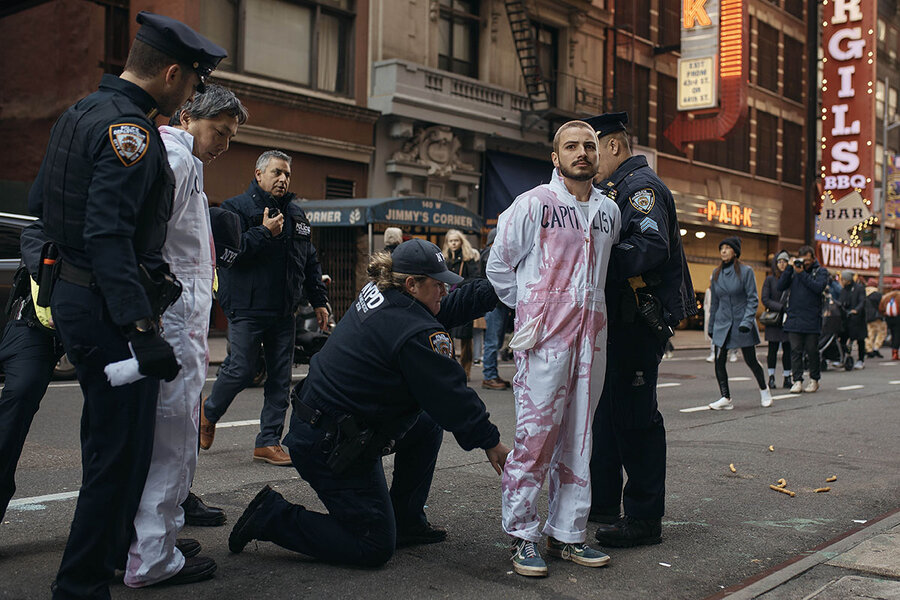As protests continue, cities juggle speech and safety concerns
Loading...
| New York
Rue, a nursing student from Brooklyn, joined hundreds of mostly young pro-Palestinian demonstrators waving flags and homemade signs on a frosty evening in Manhattan at the annual lighting of the Rockefeller Center Christmas tree.
Wednesday’s demonstration was the latest in a series of pro-Palestinian protests and acts of civil disobedience in New York and other cities. They are designed to draw attention to Israel’s deadly bombardment of Gaza since the Oct. 7 massacre and abduction of civilians in southern Israel by Hamas. In recent weeks, protesters have shut down bridges in New York and San Francisco and targeted cultural institutions. Several were arrested here last week after they glued their hands to the street to divert the annual Macy’s Thanksgiving Day Parade.
Why We Wrote This
A story focused onAs protests and rallies about the Israel-Hamas war continue in the U.S., city leaders and law enforcement are tested by the need both to protect the right to demonstrate and to provide public safety.
With Gaza temporarily becalmed by a weeklong cease-fire and hostage exchanges but with no end in sight to the larger conflict, the challenge of policing protests, and the risk of escalation, remains stark for law enforcement agencies. Few have faced sustained mass protests on this scale since the racial justice marches of 2020.
“There’s no easy way out of this,” says David Couper, a former police chief in Madison, Wisconsin.
It was a frosty night in midtown Manhattan, and Rue, a nursing student from Brooklyn, had joined hundreds of mostly young pro-Palestinian demonstrators, some clad in black-and-white keffiyeh scarves, waving flags and homemade signs. The occasion was the annual lighting of an 80-foot Christmas tree at nearby Rockefeller Center, a televised event featuring Kelly Clarkson and Cher that had drawn thousands of tourists to watch live.
To Rue, who declined to give his surname, it’s a bittersweet season. “I love Christmas too, and the Rockefeller tree, but this is about people’s lives,” he says. “People [here] seem so oblivious. They’re just going on with their daily lives as if people aren’t dying every day in Palestine.”
He breaks off to move a police barricade so more protesters can enter, and then adds, “I just want to make an impact, to show that we’re here and this is happening. People can’t just forget about it.”
Why We Wrote This
A story focused onAs protests and rallies about the Israel-Hamas war continue in the U.S., city leaders and law enforcement are tested by the need both to protect the right to demonstrate and to provide public safety.
Wednesday’s demonstration was the latest in a series of pro-Palestinian protests and acts of civil disobedience in New York and other cities. They are designed to draw attention to Israel’s deadly bombardment of Gaza since the Oct. 7 massacre by Hamas of 1,200 civilians in southern Israel and the abduction of about 240 hostages. In recent weeks, protesters have shut down bridges in New York and San Francisco, targeted Democratic lawmakers’ offices, and vandalized cultural institutions. Several were arrested here last week after they glued their hands to the street to divert the annual Macy’s Thanksgiving Day Parade.
With Gaza temporarily becalmed by a weeklong cease-fire and hostage exchanges but with no end in sight to the larger conflict, the challenge of policing pro-Israeli and pro-Palestinian protests, and the risk of escalation, remains stark for law enforcement agencies. Few have faced sustained mass protests on this scale since the racial justice marches of 2020 and must tread a balance between allowing peaceful speech, monitoring extremist groups, and keeping the public safe.
“This is the ebb and flow of protest. We try to keep it calm, we let people move, and we let them exercise their rights. Sometimes things get a little hectic,” Jeffrey Maddrey, chief of the New York Police Department, told CBS’ New York station during last night’s demonstration.
Protests and police presence
Earlier this week, Within Our Lifetime, a pro-Palestinian group that the Anti-Defamation League accuses of antisemitism, called for a “Flood The Tree Lighting for Gaza”; “Flood” was reportedly a Hamas code word for its Oct. 7 assault. “PRIESTS OF PALESTINE CALL FOR MOBILIZATION, NOT CELEBRATION!” it said on Instagram.
But a heavy police presence in and around Rockefeller Center prevented protesters from entering the cordoned tree-lighting area or disrupting the ceremony, which culminated at 10 p.m. in the lighting of 50,000 LED bulbs.
Instead, more than 500 protesters gathered by a Christmas tree outside the News Corp. building nearby, where a previous sit-down protest occurred. Later, the protesters marched for several blocks and some clashed with police, leading to several arrests with tensions running high but no major violence.
Experts say police officers nationally are wary of being drawn into prolonged confrontations with protesters that fuel tensions, particularly if counter-demonstrators show up to goad the other side.
As police chief of Madison, Wisconsin, from the 1970s to early 1990s, David Couper pioneered a managed response in which police worked with protest groups to set the bounds for actions so that they could voice their message lawfully. “It is a part of the Constitution: You have a right to peaceably assemble, so how do we make that happen? But that’s changed,” says Mr. Couper. “Once you lose the idea that the police really want to help and are not the villains ... the whole thing goes crazy. [In some cities] it’s a dangerous game. It’s a contact sport.”
Some speakers at Wednesday’s demonstration harangued the NYPD and called it complicit in Israeli killings of Palestinians, while protesters accused the police of making arbitrary arrests at past events. “It’s largely been peaceful,” says Rue, who has attended several in recent weeks. “But every once in a while, the police will swoop in and arrest people.”
Before the demonstration, the department laid down its ground rules. “The NYPD will be on hand to protect the tree lighting and all those attending, and we will not tolerate disruption or any threats to public safety,” said a spokesperson.
The nationwide protests after the police killing of George Floyd in May 2020 highlighted the broader challenge for law enforcement: Tasked with protecting public order, police can go overboard to protect their own when challenged, while protesters, in turn, push the boundaries of free speech in order to antagonize police. The upshot is a cycle of distrust that informs the next round, says Mr. Couper, who quit the police force in 1993 to become an Episcopal priest.
“Being able to police a diverse society requires that you have to be trusted and supported. Otherwise, the only way to do the job is more and more force,” he says.
Balancing free speech, hate, and safety
Among the protesters on Wednesday was Rivka Rosensweig, a community organizer in New York and a veteran of past Palestinian rights marches. “I’m here today because I think we are witnessing a genocide funded by the United States,” she says.
During the recent Israeli military actions in Gaza aimed at destroying Hamas, she has joined four protests in New York and two in Washington. Wednesday’s full-throated demonstration was encouraging, she notes. “I’d say, for turnout on a weekday it’s really good. It’s cold out.”
For most Jewish Americans and organizations that monitor hate speech, this wave of protests is far less encouraging. The FBI said last month that antisemitic threats to Jews were at a historic high. Not all threats are coming from pro-Palestinian militants, though; analysts say far-right groups continue to pose a greater threat to a minority that makes up 2% of the U.S. population. Officials have also reported an increase in threats against Arab and Muslim Americans since Oct. 7.
On Wednesday night, the crowd repeatedly chanted “From the river to the sea, Palestine will be free,” a slogan that to many signifies the expulsion of Israeli Jews from their country. Protesters also denounced President Joe Biden as “Genocide Joe,” underscoring the split on the left over the administration’s U.S.-Israel policy.
Ms. Rosensweig, who is Jewish, says her views are at odds with family members whom she describes as Zionists. She believes that everyone must take a stance on what is unfolding in Israel and the Palestinian territories. “Anyone, Jewish or not, with a conscience can see that what is happening is untenable and abhorrent.”
To Mr. Couper, the balancing act on protests isn’t getting any easier. When he ran Madison’s police department, he deployed officers to protect the rights of a small group of neo-Nazis to demonstrate near Wisconsin’s State Capitol. Last week, he watched as police were again on the streets in Madison to protect bystanders from a group of about 25 neo-Nazis, who shouted antisemitic and anti-LGBTQ slogans.
“There’s no easy way out of this,” he says.
Patrik Jonsson contributed reporting.









